 During a recent Roco Fast-Track 120 class in Albuquerque, New Mexico, two of our students got to use the skills they had just learned during a real world event. On Day 6 of the 12-day class, NM State Police Tactical officers Hugo Munoz and Jose Urbano received a call for assistance in the recovery of an individual that had been swept into one of the many arroyos that crisscross the region following a sudden rainstorm.
During a recent Roco Fast-Track 120 class in Albuquerque, New Mexico, two of our students got to use the skills they had just learned during a real world event. On Day 6 of the 12-day class, NM State Police Tactical officers Hugo Munoz and Jose Urbano received a call for assistance in the recovery of an individual that had been swept into one of the many arroyos that crisscross the region following a sudden rainstorm.
Here’s a photo from the Fast-Track 120 class where Officer Urbano is shown “rescuing” Officer Munoz.
The officers responded and found the local fire and law enforcement personnel on scene in the process of devising a plan to recover the victim who was entrapped under a narrow bridge in approximately 6 feet of water. Officer Urbano and Munoz joined in the planning and recommended using some of the rope techniques that they had just learned in the Fast-Track 120 class.
 The recovery plan involved the use of a mainline attached to the NM State Police Diver and a 4:1 rigged and ready to be “piggybacked” on the main line in case the diver needed immediate retrieval.
The recovery plan involved the use of a mainline attached to the NM State Police Diver and a 4:1 rigged and ready to be “piggybacked” on the main line in case the diver needed immediate retrieval.
The Diver attached a second line to the recovery bag that was placed around the victim, and the Diver exited the arroyo. Officers Munoz and Urbano attached the 4:1 to the victim’s line and removed the individual from the arroyo. All of the systems used were anchored to multiple vehicles that had responded to the scene.
 “Obviously, this makes us very proud that our students can take the techniques learned in our classes and put them to immediate use. Unfortunately, this was a recovery operation. However, we hope that everyone involved was just a little bit safer thanks to the training and capabilities of Officers Urbano and Munoz,” stated Roco Chief Instructor Tim Robson, who led the 120-hour training class.
“Obviously, this makes us very proud that our students can take the techniques learned in our classes and put them to immediate use. Unfortunately, this was a recovery operation. However, we hope that everyone involved was just a little bit safer thanks to the training and capabilities of Officers Urbano and Munoz,” stated Roco Chief Instructor Tim Robson, who led the 120-hour training class.
 Here's a photo of the scene of the recovery near an arroyo in Albuquerque, New Mexico.
Here's a photo of the scene of the recovery near an arroyo in Albuquerque, New Mexico.
An arroyo is defined as a small, deep gully or channel of an ephemeral stream. Arroyos usually have relatively flat floors and are flanked by steep sides consisting of unconsolidated sediments. They are usually dry except after heavy rainfall. In this area, there are several miles of open-air concrete lined drainage channels that drain an area into the main North Diversion Channel, a tributary of the Rio Grande joining upstream of Albuquerque.
Signs are posted at the constructed arroyos warning to keep out due to danger of flash flooding and other obvious dangers.

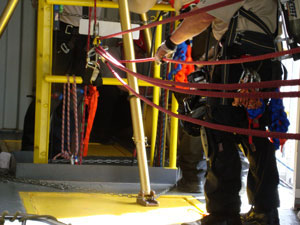 As an employer with permit-required confined spaces, you’ll need to determine if your rescue team or selected rescue service can truly “walk-the-walk” when it comes to confined space rescue. OSHA’s Permit Required Confined Space Standard (1910.146) is “performance-based” – meaning it’s all about capabilities when the stakes are high.Conducting a performance evaluation of your rescue service is a vital component in determining their true capabilities as well as fully meeting the performance requirements of 1910.146.
As an employer with permit-required confined spaces, you’ll need to determine if your rescue team or selected rescue service can truly “walk-the-walk” when it comes to confined space rescue. OSHA’s Permit Required Confined Space Standard (1910.146) is “performance-based” – meaning it’s all about capabilities when the stakes are high.Conducting a performance evaluation of your rescue service is a vital component in determining their true capabilities as well as fully meeting the performance requirements of 1910.146.
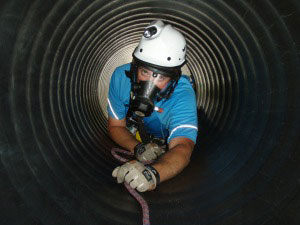 During the initial evaluation the employer should interview the prospective rescue service or team to determine response times, availability, a means to summons in the event of an emergency, reciprocal communications should the service/team become unavailable, whether they meet the requirements 1910.146 paragraph (k)(2), and whether they are willing to perform rescue at the employer’s workplace.
During the initial evaluation the employer should interview the prospective rescue service or team to determine response times, availability, a means to summons in the event of an emergency, reciprocal communications should the service/team become unavailable, whether they meet the requirements 1910.146 paragraph (k)(2), and whether they are willing to perform rescue at the employer’s workplace.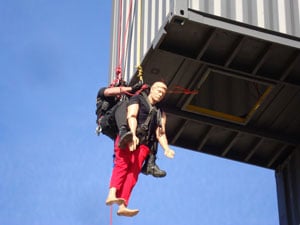
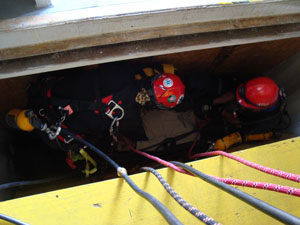 “As part of each practice session, the service should perform a critique of the practice rescue, or have another qualified party perform the critique, so that deficiencies in procedures, equipment, training, or number of personnel can be identified and corrected.”
“As part of each practice session, the service should perform a critique of the practice rescue, or have another qualified party perform the critique, so that deficiencies in procedures, equipment, training, or number of personnel can be identified and corrected.”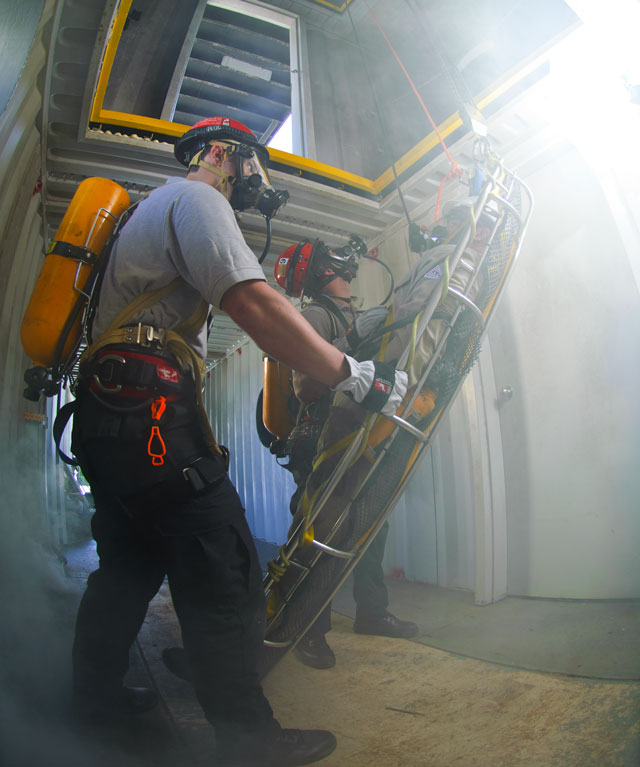
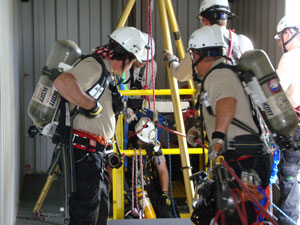 For all those employers who have workers entering confined spaces to work, we hope that you will carefully consider this rescue evaluation process – it could save a life or even prevent multiple fatalities. For you rescuers out there, we hope that you will do everything you can to maintain and increase your proficiencies – so when the time comes, you can walk-the-walk with pride in a job well done.
For all those employers who have workers entering confined spaces to work, we hope that you will carefully consider this rescue evaluation process – it could save a life or even prevent multiple fatalities. For you rescuers out there, we hope that you will do everything you can to maintain and increase your proficiencies – so when the time comes, you can walk-the-walk with pride in a job well done. The Orange (Texas) Fire Department recently completed Roco’s Fast-Track™ 120 course, which is arguably the ultimate rope rescue training experience.
The Orange (Texas) Fire Department recently completed Roco’s Fast-Track™ 120 course, which is arguably the ultimate rope rescue training experience. 
 With a large concentration of industrial facilities within its response area, the Orange Fire Department has a unique responsibility to the community as well as the surrounding industries who play such a vital role in the local economy. In delivering the highest level of service, it is important for OFD Firefighters to be trained in both Confined Space and Rope Rescue techniques.
With a large concentration of industrial facilities within its response area, the Orange Fire Department has a unique responsibility to the community as well as the surrounding industries who play such a vital role in the local economy. In delivering the highest level of service, it is important for OFD Firefighters to be trained in both Confined Space and Rope Rescue techniques.


